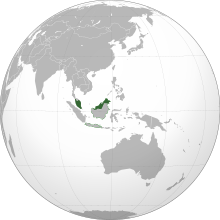Malaysia's independence in 1957 was a catalyst for growth. As the nation took charge of managing its own affairs, it continued to develop the goals and means necessary for a financial structure conducive to the economic growth observed today. Critical to the transition of Malaysia from a low-income country to one of high-income status has been the expansion of its economy. From a commodity and agricultural-based economy, the Southeast Asian nation is transitioning to a leading exporter of more complex goods. As the nation opens up to trade and investment, the World Bank and the International Bank for Reconstruction and Development (IBRD) and International Development Association (IDA) continue to assist with its development.
 | This is a user sandbox of Evartsco. You can use it for testing or practicing edits. This is not the sandbox where you should draft your assigned article for a dashboard.wikiedu.org course. To find the right sandbox for your assignment, visit your Dashboard course page and follow the Sandbox Draft link for your assigned article in the My Articles section. |
 | |
| Established | March 7, 1958 |
|---|---|
| Type | World Bank Group Member |
| Purpose | Economic & Financial Development |
| Headquarters | Kuala Lumpur |
| Services | Guide Financial and Economic Development |
History with the World Bank
Malaysia joined the World Bank following its independence in March 7, 1958, following a resolution to first join the International Monetary Fund.[1] The World Bank continues to identify areas of growth necessary for the Malaysian economy. It cites a need for reduce poverty, income inequalities. Although the growth of the Malaysian economy has been significant, it still trails relative to regional and national competitors of a similar nature.[2]
First Power Project for Malaysia
Malaysia received its first loan from the IBRD in 1958.[3] The proposed loan expected the IBRD to provide 70% of financing, or around USD $51.2 million.[4] These funds were commissioned for the Cameron Highlands District, approximately 100 miles of Kuala Lumpur, as a part of a comprehensive plan to develop energy infrastructure. The hydroelectric power station created as a result of the loan channeled the several local waterways that flowed through the plateau-region. Project completion resulted in diversion tactics, new power stations, and a concrete damn. The project represented the needs greater power demand in the state.
1990's
Throughout the 1990’s Malaysia continued to receive World Bank loans meant to assist the state’s development and diversify the growth of its predominantly agricultural and commodity-based economy.[5] Following its receipt and use of IBRD loans, Malaysia choose to seek relations via a reimbursable advisory services framework (RAS). Malaysia now interacts with the World Bank Group as an upper-middle income economy as a member of the IDA.
Asian Financial Crisis
Although Malaysia was afflicted by the 1997 Asian financial crisis, its economy bounced back with an average growth rate of 5.4% and is on a current upward trajectory.[6] Malaysia's resilience to the financial crises and successive growth was attributed to the presence of well established foreign banks, among these HSBC and Standard Chartered.[7] The presence of foreign banks allowed the state to develop comprehensive data sets regarding the local economy, to the benefit of Malaysian domestic banks. In tandem with the success of Malaysia post-crisis was the growth of physical capital stock.[8] Policies in Malaysia continued to facilitate the flow of foreign direct investment and improved import relations with foreign states.
World Bank Group Global Knowledge and Research Hub
The World Bank Group Global Knowledge and Research Hub in Kuala Lumpur anchors the WBG’s presence. The Hub was established in 2016 and represents the first organization of its kind. Its focus is to disseminate knowledge Malaysians and regional neighbors can use to improve [[socioeconomic productivity. Creation of the office was underpinned by the sentiment that increasing the access to important information in the region would lead to greater economic growth. The organization works to share keys to Malaysia success with emerging and developing markets transitioning from poverty, to propagate development policy research in tandem with other research institutions and to guide Malaysia rise to a high-income economy. Costs of the Hub were agreed to be financed by Malay government over the course of a five year-term.[9] The Knowledge and Research Hub works in tandem with the Development Economics (DEC) Research Group and Indicators Group, also a part of the WBG.
The role of the Hub is information specific. It is meant to use information flow from external actors and its RASs along with information it sends out to understand labor market policy and public spending influences. The RASs are pivotal in providing infrastructure, transportation and public spending data.
New Financial Instruments
The creation of the green sukuk, or green Islamic bond, is an innovation catalyzed by the World Bank. The bond has identified as a climate finance tool for cities and low carbon infrastructure projects meant to stimulate private sector investment.[10]
Addressing Poverty
Less than 1% of the nation exists at extreme poverty. In addressing the state of poverty in Malaysia, the government has turned to the lower 40% tier who remain vulnerable to economic disturbance.[11] Knowledge developed from the Hub is meant to address key concerns in these areas.
References
Wikiwand in your browser!
Seamless Wikipedia browsing. On steroids.
Every time you click a link to Wikipedia, Wiktionary or Wikiquote in your browser's search results, it will show the modern Wikiwand interface.
Wikiwand extension is a five stars, simple, with minimum permission required to keep your browsing private, safe and transparent.